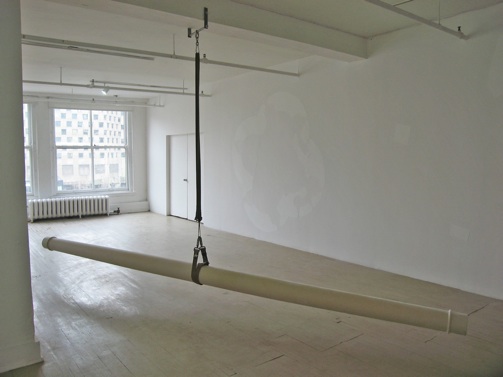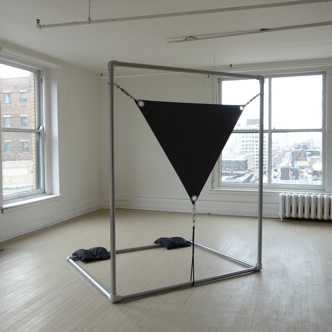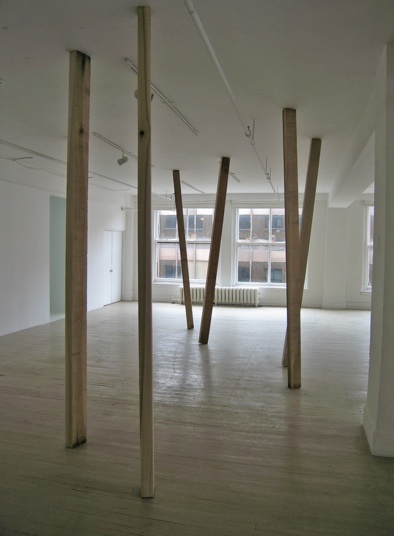29 Hits for MPVite
- MPVite :
- Romain BOULAY
- John CORNU
- Clément LAIGLE
- Luc MATTENBERGER
Since 2007 MPVite (‘manifestly painted fast’ is the rough English translation), a group originally based in Nantes, has presented 29 exhibitions of new works, most often created on site and in response to the local environment. At CIRCA, after three weeks of an intense production residency, four artists have created works that echo the architecture of the place or that re-position forms derived from an architectural vocabulary into an exhibition context.
Clement Laigle’s work offers the public a visual experience that is revealed gradually. Extended onto the large wall at CIRCA, American Standard is a white-on-white basrelief of two somewhat complex geometric shapes. The source of these shapes refers to the architectural plans of medieval castles designed by architect Eugène Emmanuel Viollet-le-Duc in the nineteenth century. It is through moving one’s body in relation to the wall that one discovers the textures of the oversize motifs. Near the wall mural, an element that looks like a beam or a pipe (Mony GA) is suspended from the ceiling. This object, outside of its original context, becomes the bearer of a new direction, where its potential functions are left to the imagination of the viewer.
John Cornu has created an installation that corresponds to the surroundings, specifically the large windows at CIRCA. The piece, Comme un gant (Like a Glove), is composed of eight black monoliths positioned in a circle that takes the form of church buttresses (documentary sculpture). Since the buttresses are upside down and stripped of their supporting role, they are barely recognizable. The positioning of the sculptural elements mimics some panoptic prisons (in star formation) where only guards, positioned at the center, can see what is happening in each section. This installation also refers to the body. In order to assess the way the sculpture functions, visitors are invited to move between the elements.
The relationship of the work to the visitor’s body also interests Luc Mattenberger who has been working for several years on the concepts of force and power. The artist uses a variety of strategies to create moments of latent waiting and suggested fear. His two presented sculptures are made of glass, a material commonly used for construction, as well as metal pipes generally found in temporary emergency shelters. However, in Untitled (Stretched), it is difficult not to project a use related to the torture of the body and, in Untitled (Restricted), one has the impression that the piece itself might be dangerous as well as fragile.
Finally, Roman Boulay created Étais indigènes (Indigenous Props) with yellow poplar beams – a rare and expensive product in Europe. He cut the posts lengthwise, revealing the pigments of the tree’s growth rings that are surprisingly similar to some painterly effects. The positioning of these beams in the space is calculated to deliberately allow movement inside of the installation. The overall effect is that of a junction between the floor and ceiling. This link between the two spaces oscillates in the perceptions of architectural support, tension or compression.
Geneviève Goyer-Ouimette
Romain Boulay
Romain Boulay lives and works in Nantes and Brussels. He has participated in many exhibitions in France and abroad. His work questions the relationship of painting to space:
“ Romain Boulay shifts our comprehension of the traditional two-dimensional space of painting toward the third dimension, in a mode distinct from minimalism. Indeed, it is not toward the object that his practice is aimed, but toward an understanding and an exploration of the painting as a volume and a place where the gaze exists (Les Peintures immatérielle) and, more recently, the body of the viewers (in sculptures-installations and his work’s architectural displays).” 1
Since 2005, in parallel with his artistic work, he has developed the activity of curating within the non-profit organisation Manifestement Peint Vite(MPVite), questioning the relationship of artists to exhibition places, in particular the concept of the White Cube and its neutrality. In 2012, he became director of MilleFeuilles, a production platform comprised of 18 artists’ studios.
1 : Excerpt from Tristan Trémeau’s text.
John Cornu
John Cornu mainly works in situ, adapting his practice and formal language to the spaces that he occupies: an architectural graft on Le Corbusier’s Villa Savoye, an exhibition of burnt stretchers in a gallery, or the “wild” cleaning of a portion of wall in a public space. His works often evoke the theme of travesty, tracing “the contours of a manipulated reality where what we are given to observe never corresponds exactly to what we think we are observing” (Christian Alandete). Often considered as rhizomic, these works seem to slip into an interstice between minimalism and romanticism.”1
His work has been exhibited in solo and group shows in France at Palais de Tokyo, la maison rouge, Cneai, Parvis, EAC, Abattoirs – Frac Midi-Pyrénées, Musée des Beaux-arts de Rennes, Musée des Beaux-arts de Calais, Biennale de Lyon, as well as abroad at MACRO (Rome), Sainsbury Center for Visual Arts (Norwich), Chambre blanche (Québec), ZQM (Berlin), Nuit Blanche de Montréal, Biennale de Busan… The first monograph devoted to the French artist was published in conjunction with the exhibition John Cornu, Assis sur l’obstacle at Palais de Tokyo, Paris, in February 2011.
John Cornu is represented by the galleries Anne de Villepoix, Paris and Sébastien Ricou, Brussels. 2
1 : Quote of Christian Alandete
2 : © Daria de Beauvais
Clément Laigle
After a postgraduate work in Geneva in 2008, Clément Laigle moved to France where he continues to work. His work oscillates between sculpture and installation, with numerous back and forth moves towards the 2D. In 2011, he also co-founded MBDTCurators, an entity having the vocation to promote contemporary creation to the public and to professionals from the art world.
Luc Mattenberger
Luc Mattenberger is a Swiss artist who lives and works in Geneva. He completed postgraduate studies at the Geneva University of Art and Design (HEAD) and received his MFA (Honours) in 2007. He works primarily in the fields of sculpture and installation. His work explores the many relationships of man to machine with a particular interest in the engine as conveyor and symbol of power. During his career, the artist has been awarded several prizes such as the Prix d’art de la Nationale Suisse, the Prix de la Ville de Genève, the Prix de la Fondation UBS as well as the Prix fédéral d’art 2011. He has had international art residencies in Berlin (zwanzigquadratmeter, 2008), in Paris (Fondation Simon I. Patiño, 2009), in Prague (Pro Helvetia, 2011), in Rome and at CIRCA (Montreal, 2014). Mattenberger is the co-founder and co-editor of the literary magazine Coma.
The first detailed and fully illustrated monograph of Mattenberger’s work was published in 2010. 1
1 : Luc Mattenberger, ‘’No Country for Engines,‘’ Fondation AHEAD, Genève, 2010, 72 pp.
Geneviève Goyer-Ouimette
Geneviève Goyer-Ouimette has been director of CIRCA art actuel since 2013. She has a BA in Art History and an MA in Museology from University du Québec à Montréal. At the Musée national des beaux-arts du Québec, she worked in the Department of Conservation and Research, and was responsible for the Collection Prêt d’œuvres d’art (CPOA) (a rental collection of artworks for public agencies). As a curator, she has presented numerous group exhibitions including Projet HoMa (Maison de Culture Maisonneuve and Guido Molinari Foundation) and Ornementation identitaire (Mexican Consulate in partnership with the CALQ and the FONCA). She also presented the survey exhibitions of Catherine Bolduc’s work, Mes châteaux d’air (EXPRESSION Centre d’exposition de Saint-Hyacinthe and Salle Alfred-Pellan at Maison des arts de Laval) and Eric Ladouceur’s Possession / Knowledge / Power (Musée d’art contemporain des Laurentides and Graff Gallery). She has written essays for both artists and art magazines, on the work of Catherine Bolduc, Eveline Boulva, Yvon Chassé, Marc-Antoine K. Phaneuf, Éric Ladouceur and Marcel Marois. In November 2015, as curator, she will bring together the work of ten artists in an exhibition Dialogues about Space, which will be presented at CIRCA art actuel.






